The Improved Martini?
Nearly every source describes this original Westley Richards patent, hinged tipping block, single-shot design as an "Improved Martini". This terminology is so ubiquitous that even prominent merchants of fine vintage arms use it unthinkingly. The esteemed Walter Winfer, acknowledged as the guru of British single shot lore, uses it freely. But Winfer at least makes it clear that the moniker is technically incorrect. The Martini design was a hammerless modification of the original Peabody action design. However, the Westley Richards design is similar only in the respect of a hinged breechblock that tips down for loading. None of the rest of the internals share any commonality. Whereas the Peabody has an external hammer and the Martini a striker, the Westley Richards has an internal hammer with an integral firing pin. More to the point, the Westley Richards design predates the Martini, so its clearly not an improvement on that design. In fact, the Westley Richards design was a competitor with the Martini for British military contracts. After losing out to the Martini for the British Army, the Westley Richards design was marketed heavily to the pioneers and settlers of the Dutch Boer colony of South Africa in both musket and sporting rifle forms.

Right profile of my rifle showing classic Westley Richards sporter lines
The design (including the Model 1871 and its variants) was extremely popular in the Cape colony and was followed by improvements and variations for several years, competing well against Westley Richards' own Deeley-Edge patent falling block design and remaining in production until the expiration of the Gibbs Farquharson patent rights around the turn of the century and its release to the trade prompted the firm to develop the similarly styled Model 1897 Westley Richards New Model Underlever Rifle, which was the ultimate evolution of the Deeley-Edge action. There is much confusion regarding the various models, in part because Westley Richards continually advanced the design and also made individual rifles to order. The Model 1869 is distinguished from the later larger framed Model 1871 most easily by examining the length of the lever in relation to the trigger guard; in the Model 1869, the lever does not extend much rearward past the small trigger guard, whereas on the Model 1871, it comes well past the long trigger guard.
The .450 Number 1 Carbine Cartridge
The original cartridges developed for the Model 1869 rifle were the .450 Number 1 Musket (2-5/16 inch case) and .450 Number 1 Carbine (1-1/2 inch case). The .450 Number 1 Musket duplicated the ballistics of the .577/.450 Martini-Henry cartridge while the .450 Number 1 Carbine provided a lower powered load for lighter rifles used by cavalry and mounted infantry. It drove a 380 grain paper patched soft lead bullet with 55 grains of blackpowder at 1300 fps. These cartridges were among the first to be loaded with the solid drawn brass cases that were the innovation of Westley Richards - one of the principal technological developments of all modern firearms. Sometimes you see this cartridge designated the .500/.450 No. 1 Carbine, and indeed the case head dimensions are nominally similar to the .500 Express case, although the Westley Richards rim is substantially thicker. There is another .450 Carbine cartridge that you will encounter in old ammunition catalogs and occasionally in example, which is a much less powerful taper case cartridge. In modern terms, the Westley Richards .450 Number 1 Carbine compares reasonably well to the .454 Casull, .480 Ruger or .475 Linebaugh, which is to say that its not puny by any means.
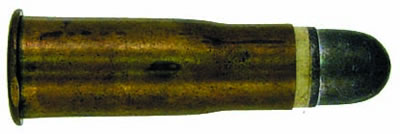
Original .450 Westley Richards No. 1 Carbine cartridge on solid drawn brass case with 380 grain paper-patched lead bullet
The Westley Richards Model 1869 Sporting Rifle
I acquired this rifle by a proxy bid with the now lamentably defunct auction house of J. C. Devine. I got the rifle for a very decent price considering its condition. At the time I had designs of rechambering it to .450 No. 1 Musket, but I have since repented of that thought.
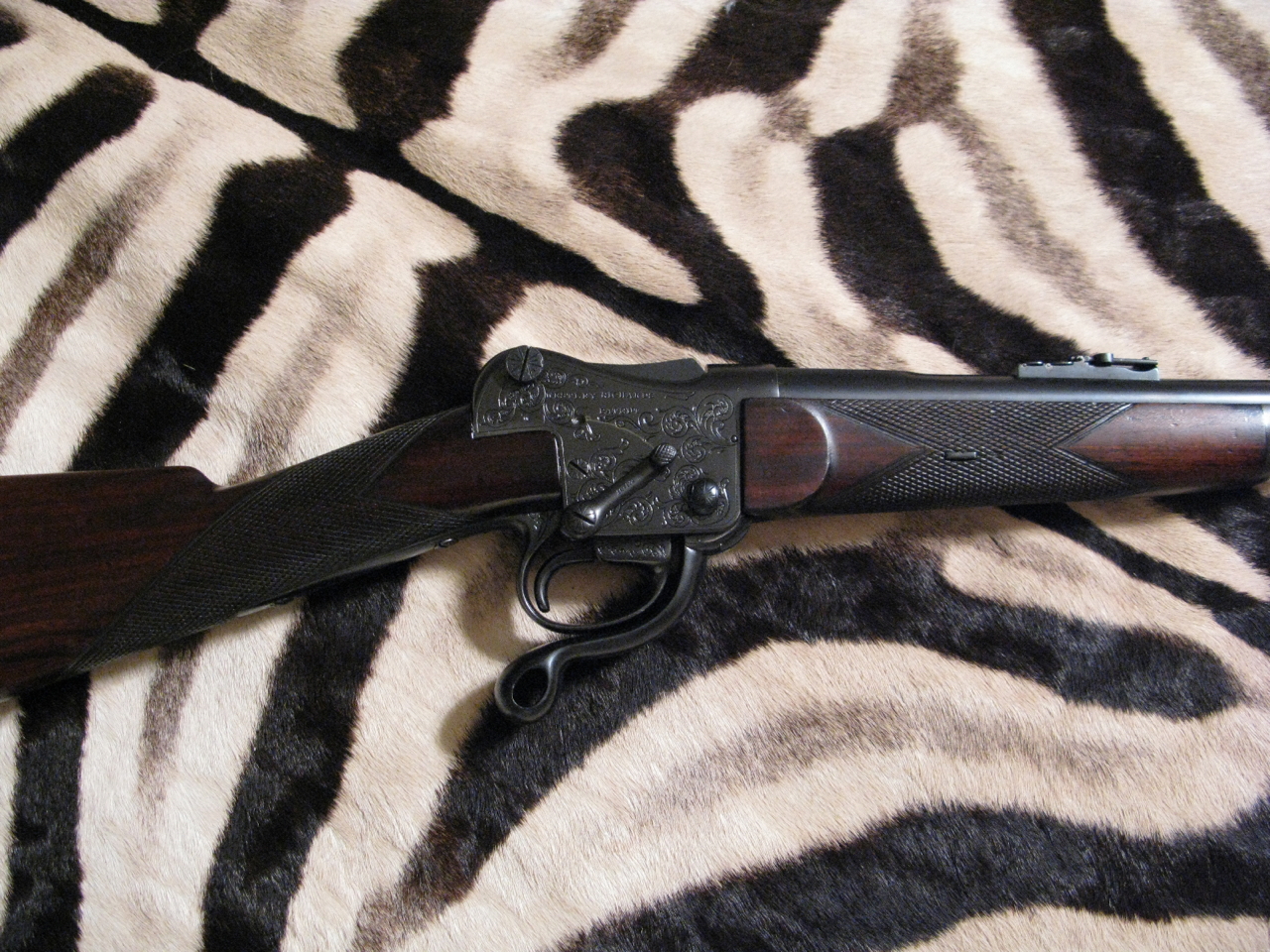
Right profile of the wrist, receiver and forearm
It is the very essence of British gunmaking elegance and simplicity. A trim, dainty thing, it weighs just six pounds even. There is light engraving of the receiver and a tasteful border around the lettering on the barrel. Judging by the evidence of use on the wood, the metal has been refinished, but if so it was done well.
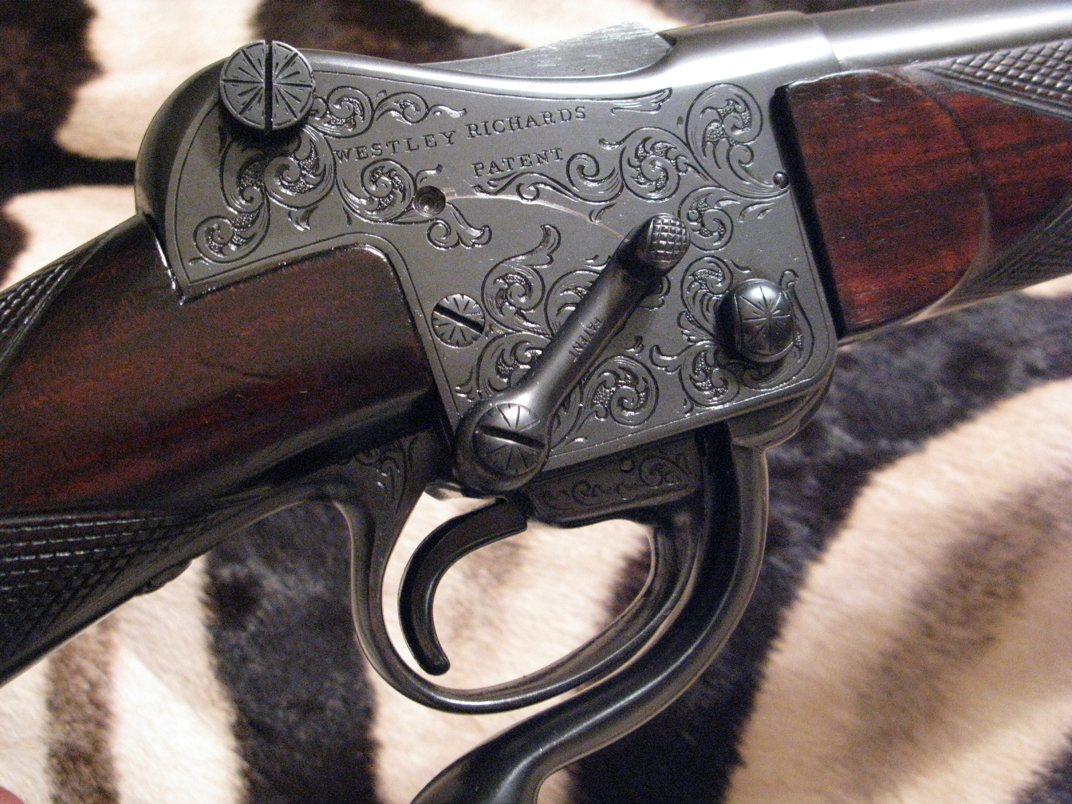
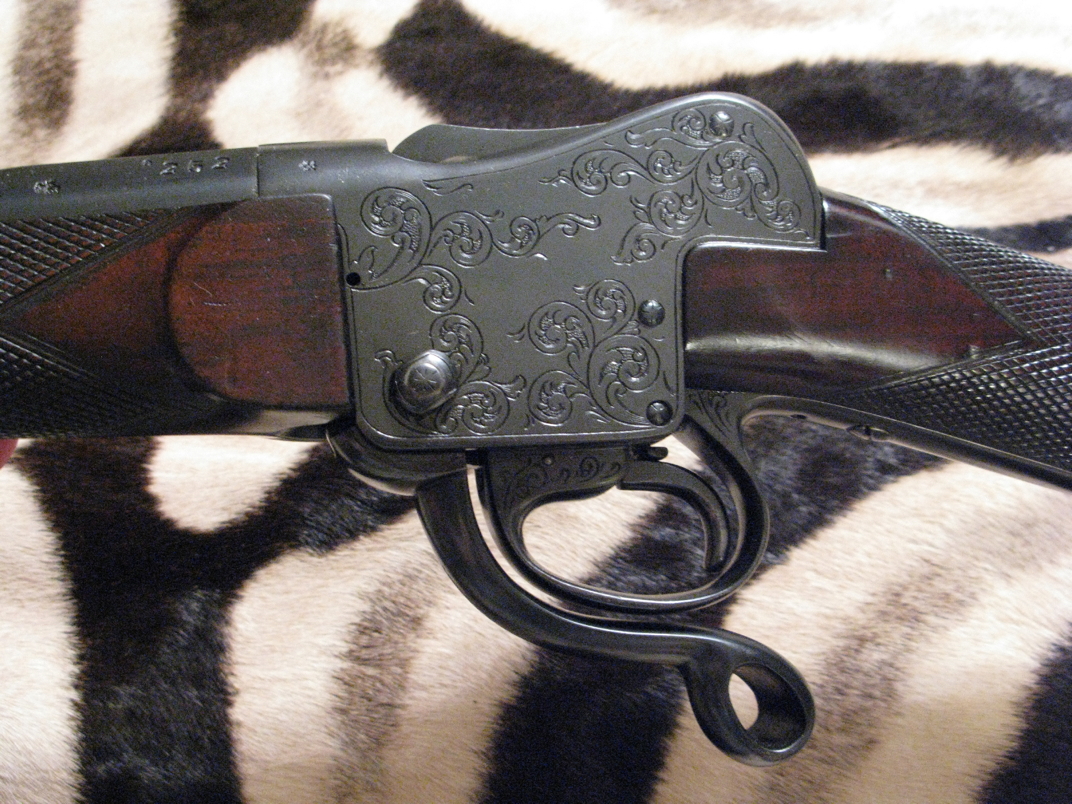
Profile views of the receiver showing Westley Richards patent marking and engraving
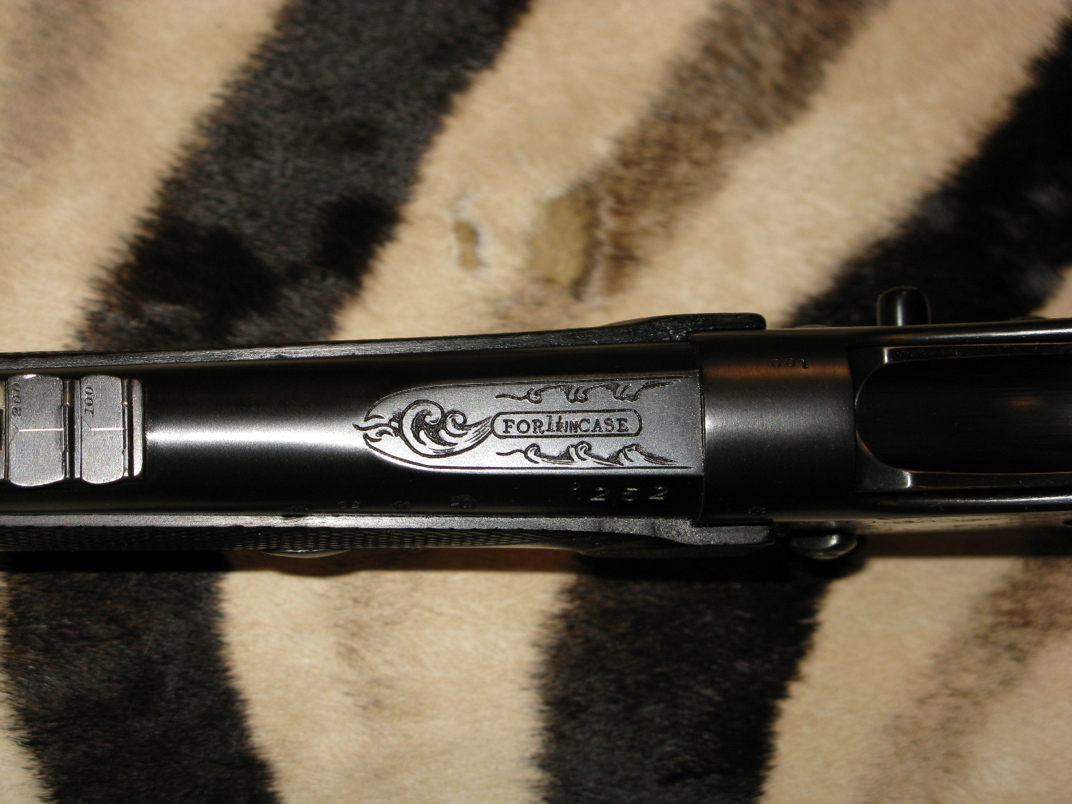
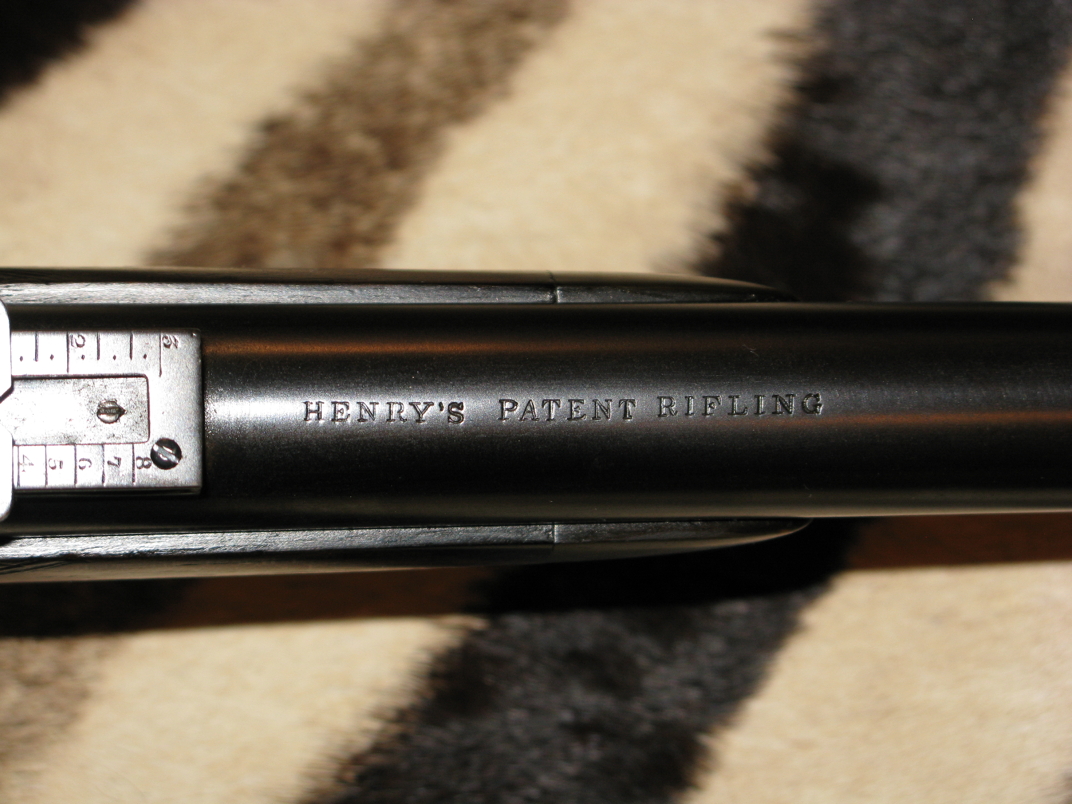
Chambering marking ("For 1-1/2 in Case") on Knox form shield and "Henry's Patent Rifling" barrel marking
The Knox form barrel is a straight taper, fairly heavy on the breech end but tapering rapidly and quite light at the muzzle, some 24 inches in length. There are two sight leaves for 100 and 200 yards (no standing sight at all) and a ladder sight (graduated to 800 yards!). There is a secondary scale on the ladder sight that I have not deciphered yet. The underlever of the action is cranked, in this case to the right, as is true for all Westley Richards Model 1869 and 1871 rifles. It has a functional safety lever on the right side that works simply by preventing the trigger from moving upward (you can actually see it in action - the mechanism is entirely external).
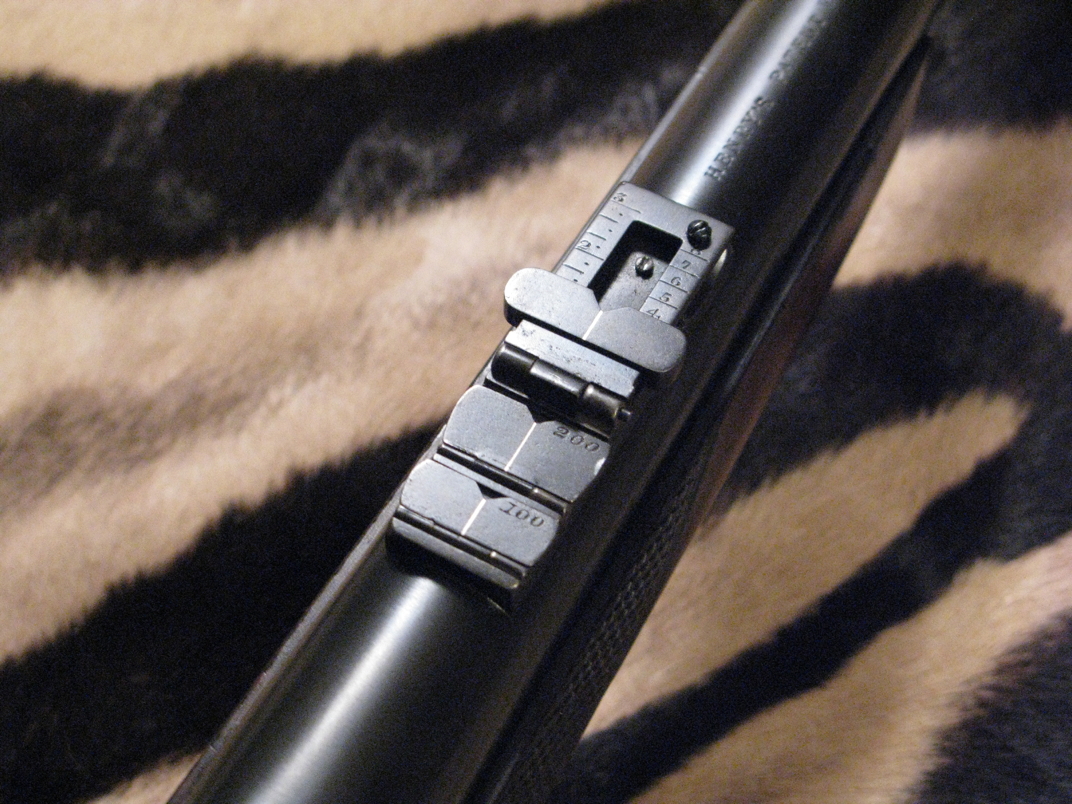
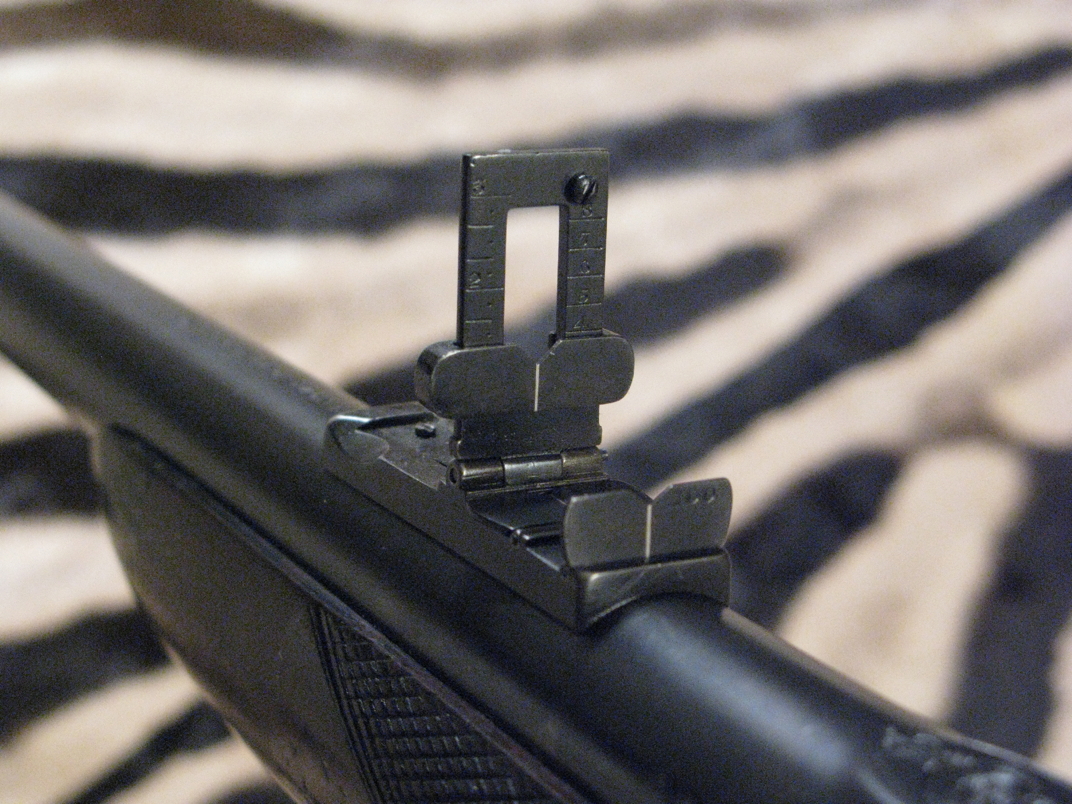
Closeup of folding sight leaves and raised ladder sight

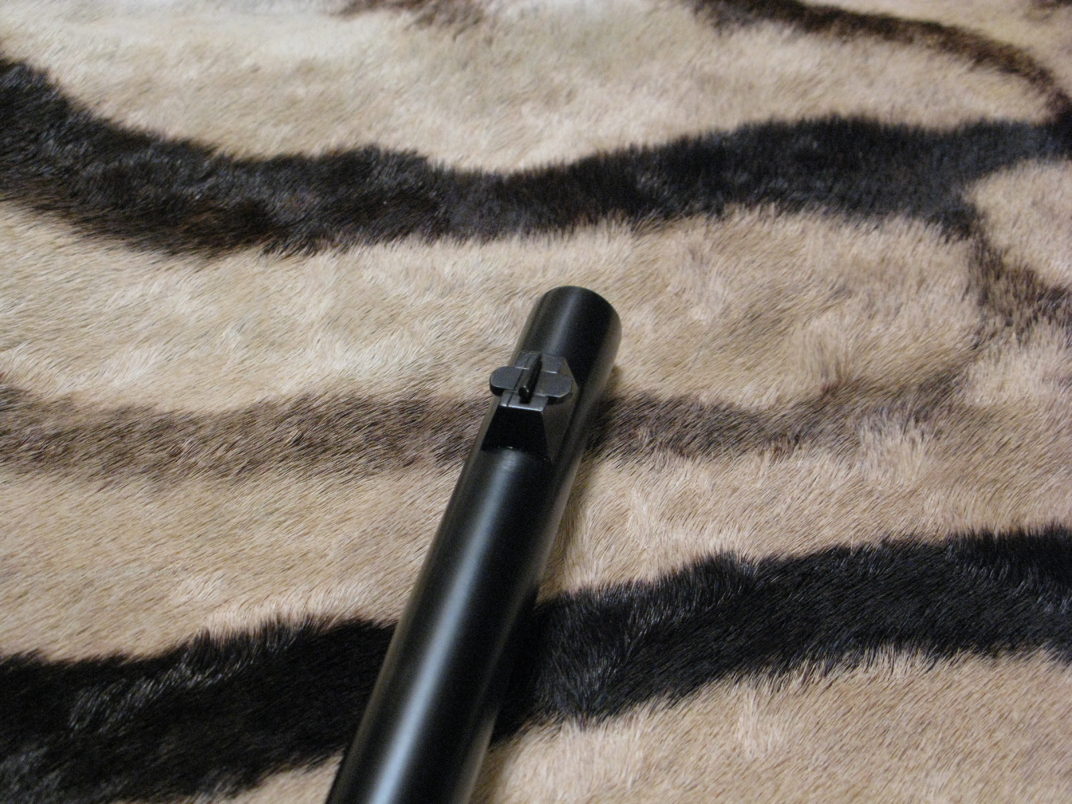
View of cranked underlever and front sight
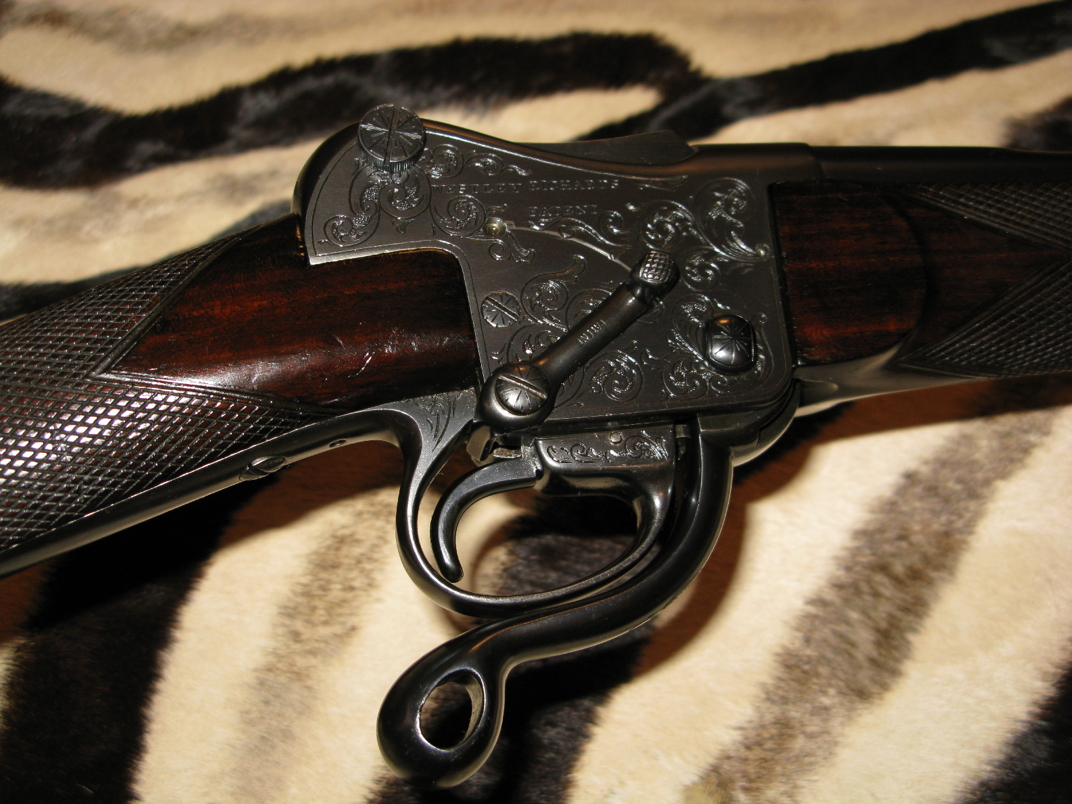
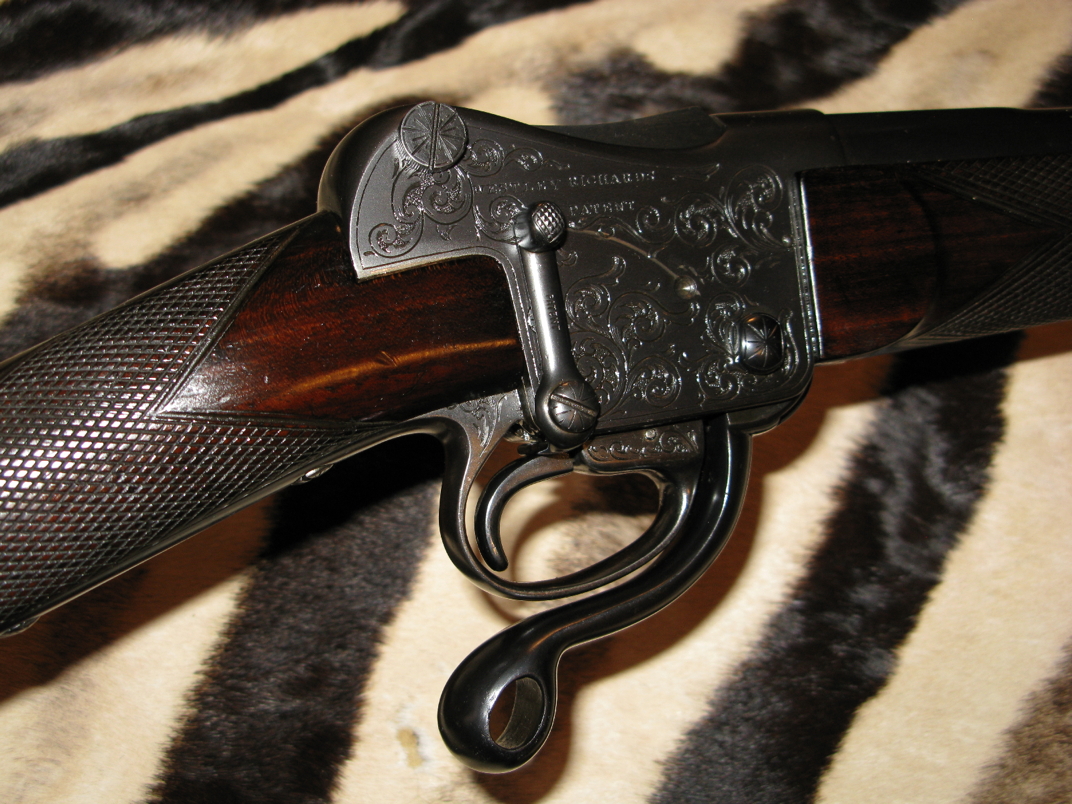
View of the safety lever in the firing and blocked positions
It is straight stocked with a short, very British, forearm and no wiping rod under the barrel. Some Westley Richards rifles were built with pistol grip stocks, although I have not yet seen a Model 1869 rifle so stocked that was chambered for .450 No. 1 Carbine (I have seen a Model 1871 in that configuration). The forearm is secured by a cross key in the manner of practically all muzzleloading sporting arms up to this date. The grip and forearm have bordered flat top checkering and the forearm tip is of sculpted buffalo horn.
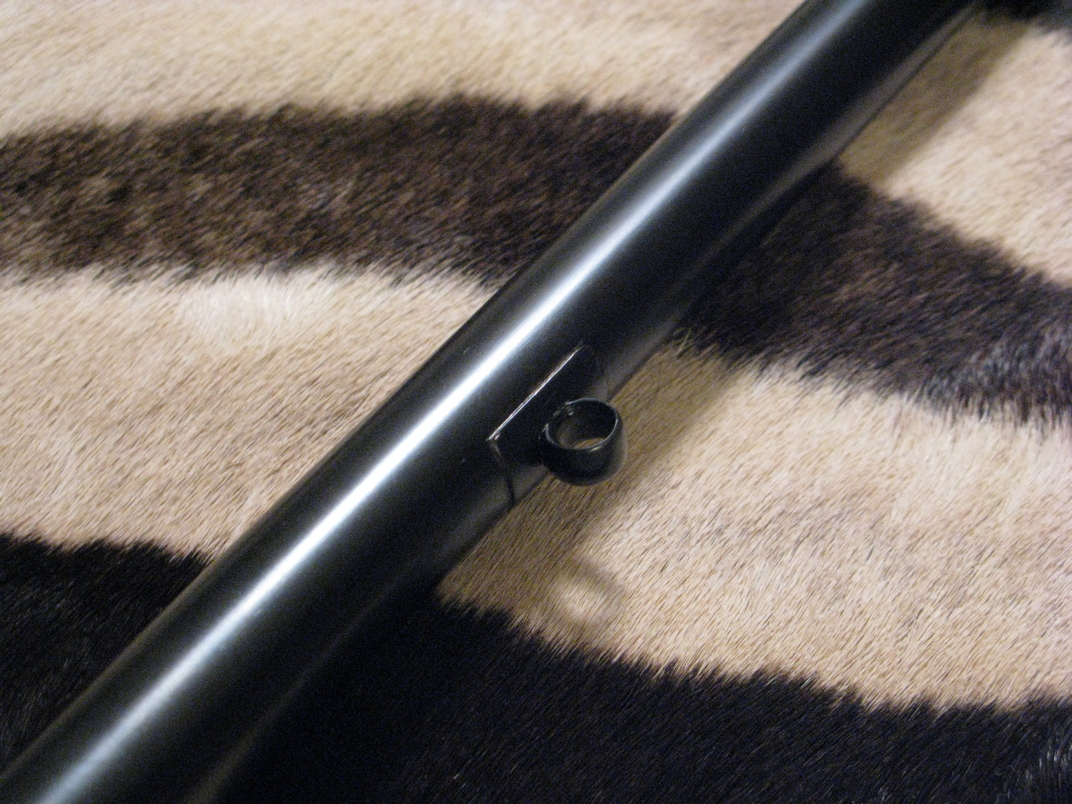
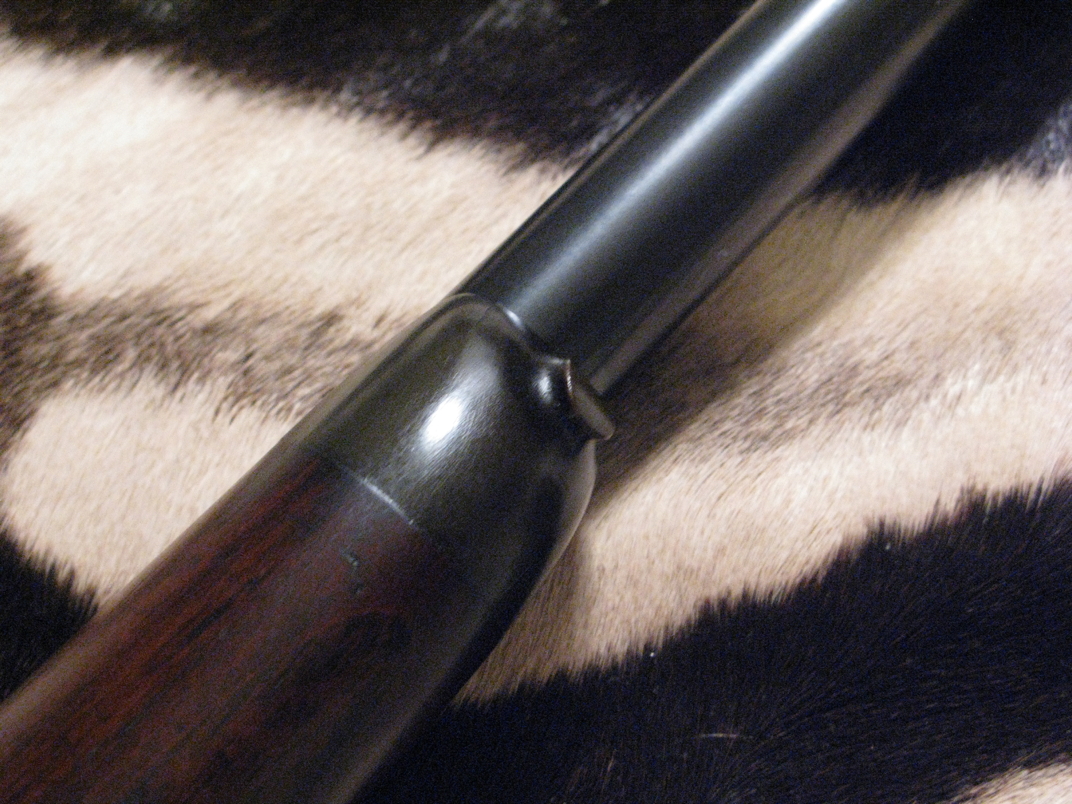
Closeup of sling eye loop and sculpted buffalo horn forearm tip
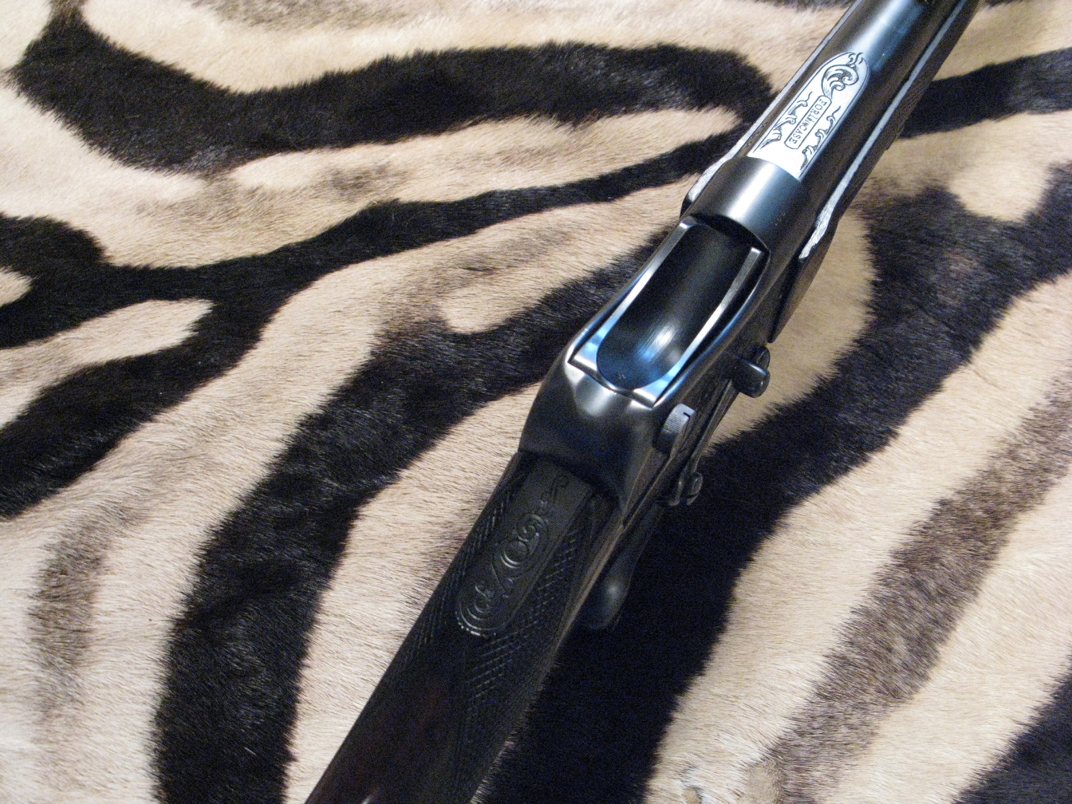
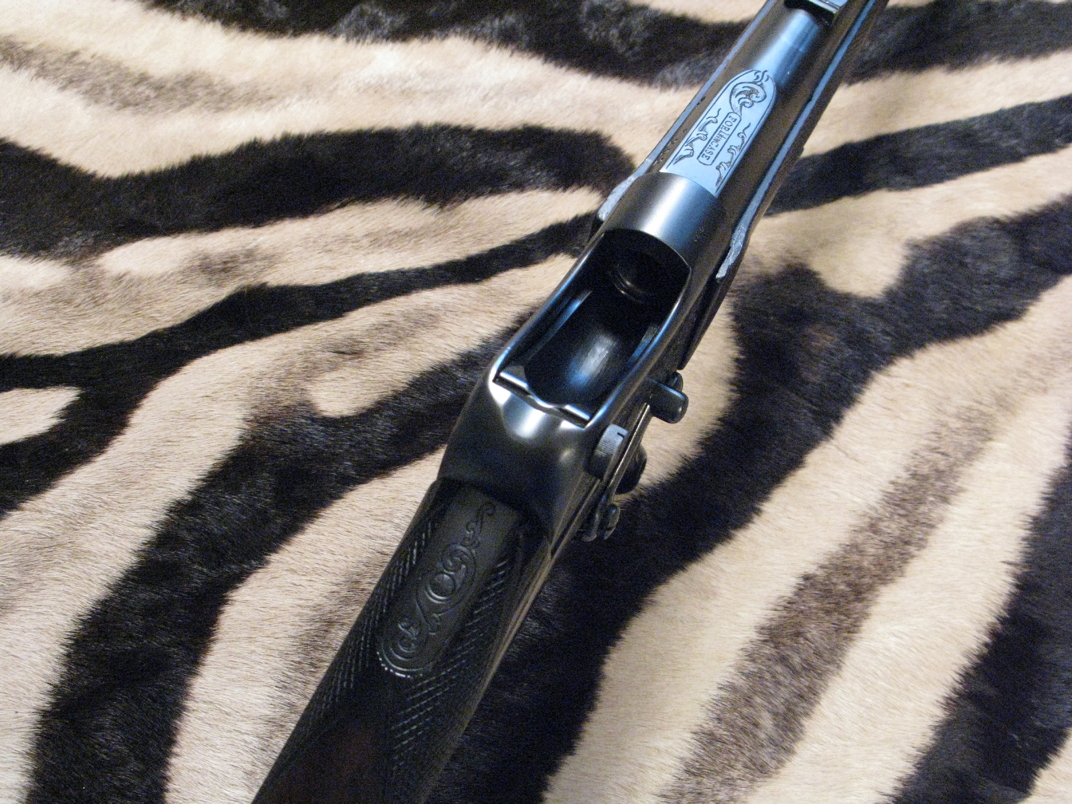
Closeup of receiver showing the breechblock in the raised and lowered positions
Load Development and Shooting
Load Development
The .450 No. 1 Carbine was originally loaded to 11 tons per square inch of pressure using the axial or base copper crusher method. In modern terms, this corresponds to a pressure of 27,900 psi as measured by the radial or side piezo transducer method or 28,900 CUP as measured by a radial copper crusher. Which is to say that its loaded to roughly the same as the original Trapdoor Springfield using 19th century blackpowder (which was stronger than 20th century formulations).
Using this fact as a guide, I measured the case volume of a fire-formed .450 No. 1 Carbine case (in grains of water) and compared it to the volume of a .45-70 cartridge case. I made an attempt to correct for the net volume available with a seated bullet and then used this volume ratio (0.8:1) to scale loads for the .45-70 Trapdoor Springfield and lever actions having a mean average pressure less than 28,000 CUP (Caution: most published lever action load data for the .45-70 has maximum pressures in the 35,000 to 40,000+ psi range). Interestingly, this proportionality works out to very close to 55:70, or the ratio of the original blackpowder loads of these two cartridges.
Another excellent data source for comparison was the published load data for the .45-75 Winchester (WCF) in the Lyman Reloading Handbook 49th Edition, as this cartridge is very similar to the .450 No. 1 Carbine in case capacity and performance. There is a more complete set of that data at LoadData.com. Brian Pearce was able to achieve 1522 fps with the 335 grain Lyman 457122 Gould bullet using Varget, and 1417 fps with the Hornady 350 grain FN using the same powder. Accurate 2015 delivered 1508 fps with the 335 grain Lyman 457122 Gould bullet. Loads with IMR-4198 and A-5744 were much less ambitious and mirrored original ballistics. These are important benchmarks.
The rule that I applied was to develop the load series up to either the predicted velocity or the predicted maximum load, whichever was achieved first. In general, the velocities did not quite attain what I expected. Velocity should roughly scale according to the square root of propellant mass ratio, but in practice it worked out to something closer to a linear proportionality - or less. Even so, I was able to safely exceed the original ballistics with cast bullets and to develop jacketed bullet loads that approach original ballistics.
Note: Pay particular attention to the cartridge overall length (OAL) indicated in the load data and look at the figure below. Original loads seated the bullets out very long to make as much case volume available as possible. Why they didn't have a longer neck I don't know, but this is correct practice. The loads shown hereafter assume that the bullets are seated to the OALs shown (or longer). Using these loads with the bullets seated to conventional crimping groove or cannelure locations may well result in much higher pressures!
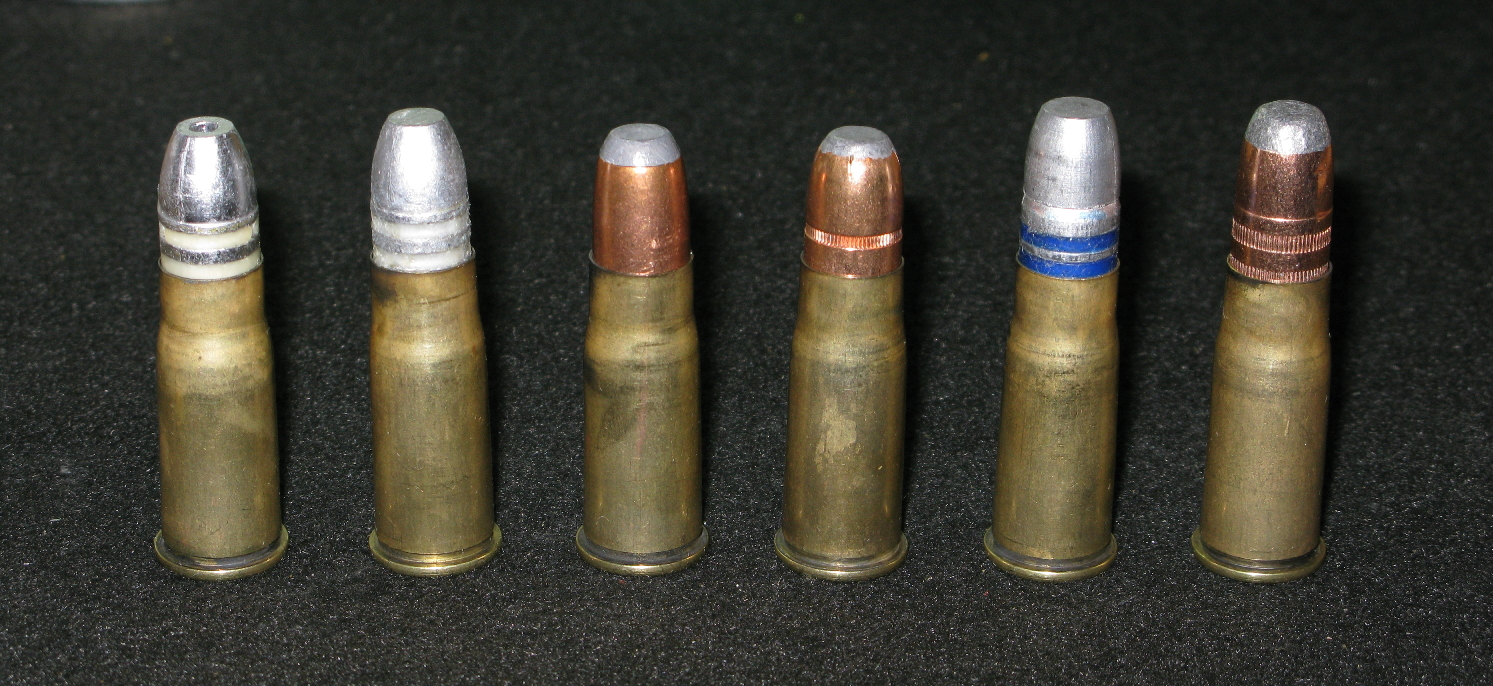
Loaded .450 No. 1 Carbine cartridges: 1) 335 gr Lyman 457122 Gould HP (Mt Baldy), 2) 350 gr Lyman 457192
Gould FN (Buffalo Arms), 3) 350 gr Hawk FN (0.025 in jacket), 4) 350 gr Hornady FN, 5) 400 gr LFN BB (Beartooth)
and 6) 405 gr Remington FN
Cartridge Cases
I used formed and properly head stamped Bertram brass for my hand loading. I have seen forum postings that describe the conversion of .50-70 Government or .348 Winchester brass into this cartridge, but the case head and rim dimensions are not identical so the results may not be entirely satisfactory. I read an online forum that suggested .45-75 WCF brass would chamber and ordered some from Buffalo Arms to try, but that did not work in my rifle. Although it might be possible to trim, size and fireform them, the rim is about 0.025 in too small and may not permit proper headspacing or extraction. The Bertram No. 1 Carbine brass comes fully formed, but is undersized for my rifle's chamber (by design I am sure, to allow for the variations in manufacturing). After the first firing the shoulder is moved forward and the body taper considerably reduced. For this reason, load development should not be attempted with virgin brass; use fireformed brass instead.

Virgin Bertram cartridge brass and fireformed resized case
Bullets
My first bullet choice was the Lyman 457192, a 350 grain FN as produced by Buffalo Arms in 20-1 alloy and lubed with SPG, so its ideal for blackpowder velocities. This is the same bullet design as the famous Ideal 457122 Gould bullet, but without the hollowpoint. I also obtained the Lyman 457122, 335 grain HP bullet in 20-1 alloy and SPG lube from Mt. Baldy Bullet Company. These two bullets together comprise the best all-around choice and can be used for any purpose to which this cartridge is suited. The Westley Richards barrel bore dimensions are designed for a true .458 caliber bullet, but a slightly oversized .459 caliber works better with cast bullets.
The Lyman 457124 bullet has a nominal weight of 385 grains and conventional round nosed profile. It was the original .45-70 Springfield bullet, weighing 405 grains in a soft alloy. I did not have any of these on hand and have not tried this bullet, but it would be perfect for someone wanting to recreate original loads using grease groove bullets rather than paper patched bullets.
Its far too hard and lubed with a high speed lube that is inappropriate to this cartridge, but because I had them on hand I loaded the .459 caliber 400 grain Beartooth LFNBB. There are other 400 to 405 grain bullets that would be better, or rather I should say that any cast bullet with a Brinell hardness of 12 or less and lubed with a soft lube should work well. Hard alloys and hard lubes will likely result in leading; these bullets did in my rifle, although not excessively. A hard alloy cast bullet in the correct diameter and lubed with SPG might work just fine. Of this weight class, the Lyman 457193 FN (also available from Mt. Baldy Bullet Co.) and the RCBS 45-405-FN GC bullet cast in 20-1 or softer alloy would probably be the best performers. An LBT style LFN or WFN bullet would make a real thumper.
I wanted to try some appropriate jacketed bullets (of which there are relatively few) in this cartridge. I tried the Hodgdon 350 grain Interlock FN, which I have found to perform well at velocities this low. The Hornady bullets were sometimes a loose fit in my brass even with good neck sizing. For that reason I intended to also try the Hawk 350 grain FN bullet with the 0.025 inch jacket. Hawk bullets routinely run 0.001 inch larger in diameter than the advertised diameter, so this is actually a .459 caliber bullet. In the end, however, especially after reviewing the results of the Hornady loads as compared with the cast bullet loads, I decided against trying this bullet for safety reasons.
I also loaded the Remington 405 grain FN. This bullet is actually far too tough for this cartridge, although its the bullet used in the very similar standard Remington factory .45-70 load. It would be a great bear buster. Its main purpose here is as a stand in for the 400 grain Speer FN, which I did not have on hand. The Speer bullet is much softer and would be great, although cast bullets will perform equally well or better.

Bullet selection used in the load development:
1) 335 gr Lyman 457122 Gould HP (Mt Baldy), 2) 350 gr Lyman 457192
Gould FN (Buffalo Arms), 3) 350 gr Hawk FN (0.025 in jacket), 4) 350 gr Hornady Interlock FN, 5) 400 gr LFN BB (Beartooth) and 6) 405 gr Remington FN
Propellant
Naturally, the first propellant to experiment with is IMR-4198 (or Hodgdon H-4198). However, dispense with the 40% nitro-for-black rule with this cartridge. That won't work in this instance. Also, fillers are neither required nor advisable when loading this cartridge. The case of the Westley Richards .450 No. 1 Carbine is small enough that it can be loaded using normal loading rules, attested by its similiarity to the .45-70 Springfield and .45-75 WCF. As evidence of the modest pressures with loads that attain and exceed original ballistics, the cases are heavily blackened with soot until the top end is reached.
The first propellant that I actually tried was IMR-3031, based on some promising performance in the .45-70. Initially, it seemed to be too slow for this application with my estimated maximum load (aimed at 21,000 CUP) and I abandoned it for a while. Eventually, I returned to IMR-3031 and I regard it as one of the best propellants for this cartridge. It burns cleanly and it delivers good consistency (those two things usually going hand in hand).
Accurate A-5744 is another smokeless propellant that works well in old blackpowder cartridges, but don't expect it to deliver any more than original ballistics or do anything that IMR-4198 won't do. I have some A-5744 but did not try it. Refer to the .45-75 WCF load data for starting loads and performance expectations.
One of the most promising propellants for this cartridge appeared to be Accurate A-2015. It gives high energy with a relatively slow burning rate for a small capacity case. There is evidence that A-2015 is the propellant giving the highest velocities at Trapdoor Springfield levels even in the larger .45-70 case, depending on which reloading data source you prefer to believe (the Speer Reloading Manual 14 favoring A-2015). Unfortunately, A-2015 also left behind an annoying amount of unburnt powder, even with top end loads. I believe that other, even slower, propellants can deliver the same performance with lower pressure and less residue to jam the action.
I switched to Hodgdon H-4895 with the jacketed 405 grain bullet on the assumption that the heavier weight would favor a slightly slower powder. A similar argument can be made for Hodgdon Varget (ADI AR-2208), which gives the best performance in the Trapdoor Springfield loads and the .45-75 loads, even with the lightest bullet weights, according to Hodgdon data and Brian Pearce's article. Even in the small case capacity of the .450 No. 1 Carbine, I think the slower propellants like H-4895 and Varget work well - arguably best. In my testing I would say that H-4895 performed best.
While I never got to the point of a completely full case or a compressed load, I was reluctant to press on beyond the maximum predicted load (based on my scaling of .45-70 loads), since this is an old antique firearm, irreplaceable and made with far less strong gunsteel than is used today. Compressed loads of H-4895 and Varget may be fine, but I will pass. If I had a true pressure measurement system I might have kept going, but I drew the line at the predicted maximum load.
For those not wishing to risk the hazards of smokeless propellant load development in an antique cartridge, the best alternative is Hodgdon Triple-7 (H-777) FFg or FFFg blackpowder substitute. Contrary to false claims on the internet, this is not a smokeless or "semi-smokeless" propellant (look at the Material Safety Data Sheet if you don't believe me - Federal law requires disclosure of toxic materials regardless of proprietary considerations). It is, however, partly composed of potassium perchlorate, which is more powerful than potassium nitrate, the primary oxidizer and energy source in blackpowder.
That has three consequences. First, it has roughly the same energy as the famed and long extinct Curtis & Harvey Number 6 grade used by the British gun trade in the heyday of cartridges like the .450 No. 1 Carbine. So loads developed with H-777 will deliver original ballistics, unlike modern blackpowder. Secondly, clean up is far easier than blackpowder; easier in fact than any propellant I have ever used. Finally, the decomposition products of KClO4 are very corrosive to gunsteel, so timely clean up is arguably more important than for conventional blackpowder. However, boiling water will leave it absolutely clean in seconds. Don't try anything fancy and by all means don't use the oily cleaning products developed for smokeless propellants. They will fail and the result will be barrel destroying metal damage. The same admonition applies to empty cases; they must be washed with warm soapy water as soon as possible to avoid damage. None of this guidance should be taken to be alarming, this propellant is amazing and wonderful stuff.
In order to establish a baseline, I loaded the .459 caliber 400 grain Beartooth LFNBB along with the 350 grain Lyman 457192 described previously using H-777. That bounds the original performance envelope of this cartridge (i.e., a slightly heavier and lighter bullet). The 35 grain (weighed) H-777 load with the 350 grain 457192 was with a fireformed case filled to the neck and with a bullet seated slightly more deeply than is necessary or consistent with original practice. The 41 grain (weighed) load is based on a 75% scaling of the original 55 grain blackpowder charge and requires a bullet seated long (per the photo) because it fills into the neck (H-777 occupying the same volume as blackpowder has a weight that is roughly 75% of the blackpowder weight). I used double fine grade, FFg, but I think in this small case that the triple fine grade, FFFg, would yield velocities more in keeping with the original ballistics.
Disclaimer
Warning: Use this load data at your own risk. No liability is assumed for the use of this data in any other firearm. It appeared to be safe in the test rifle, but was not subjected to pressure testing. Exercise safe reloading practices. Starting loads should always be reduced by at least 10% from the maximum load.
Table of Blackpowder Substitute and Nitro-for-Black Load Development Testing
| Bullet | Propellant | Muzzle Velocity | Notes |
| .458-335 gr Gould HP (Lyman 457122) |
IMR-4198 | 2.205 in OAL | |
| 30 gr | 1346 fps | ||
| 31 gr | 1312 fps | Wide variation; sooty cases | |
| 32 gr | 1408 fps | Sooty cases | |
| 33 gr | 1393 fps | Very consistent? Clean burning | |
| Accurate A-2015 | 2.205 in OAL | ||
| 39 gr | 1419 fps | ||
| 40 gr | 1396 fps | Very consistent? Unburnt propellant | |
| 41 gr | 1473 fps | Maximum; unburnt propellant | |
| IMR-3031 | 2.205 in OAL | ||
| 43 gr | 1400 fps | Consistent; clean burning | |
| Hodgdon H-4895 (ADI AR-2206H) | 2.205 in OAL | ||
| 43 gr | 1370 fps | ||
| 44 gr | 1406 fps | ||
| 45 gr | 1433 fps | Very consistent | |
| 46 gr | 1498 fps | Very consistent | |
| 47 gr | 1527 fps | Very consistent | |
| Hodgdon Varget (ADI AR-2208) | 2.205 in OAL | ||
| 44 gr | 1365 fps | ||
| 45 gr | 1348 fps | ||
| 46 gr | 1409 fps | Consistent | |
| 47 gr | 1429 fps | Very consistent | |
| 48 gr | 1456 fps | ||
| 49 gr | 1500 fps | ||
| .458-350 gr Gould FN (Lyman 457192) |
Hodgdon H-777 FFg | ||
| 35 gr (true weight) | 1190 fps | 2.165 OAL; very consistent | |
| 41 gr (true weight) | 1293 fps | 0.060 in thick card over powder; 2.205 OAL; consistent |
|
| IMR-4198 | 2.195 in OAL | ||
| 27 gr | 1129 fps | ||
| 28 gr | 1176 fps | ||
| 29 gr | 1186 fps | ||
| 30 gr | 1267 fps | Load suggested by Wal Winfer | |
| 31 gr | 1373 fps | ||
| 32 gr | 1405 fps | Clean burning; consistent | |
| Accurate A-2015 | 2.195 in OAL | ||
| 37 gr | 1293 fps | ||
| 38 gr | 1317 fps | ||
| 39 gr | 1358 fps | ||
| 40 gr | 1453 fps | Unburnt propellant | |
| 41 gr | 1470 fps | Maximum; consistent; unburnt propellant | |
| IMR-3031 | 2.165+ in OAL | ||
| 39 gr | 1232 fps | ||
| 40 gr | 1266 fps | ||
| 41 gr | 1314 fps | ||
| 42 gr | 1310 fps | Full case | |
| 43 gr | 1403 fps | Clean burning | |
| 44 gr | 1419 fps | Clean burning | |
| .458-350 gr Hornady FN | Accurate A-2015 | 2.160 in OAL | |
| 37 gr | 1231 fps | ||
| 38 gr | 1232 fps | ||
| 39 gr | 1286 fps | ||
| Hodgdon H-4895 (ADI AR-2206H) | 2.160+ in OAL | ||
| 41 gr | 1193 fps | ||
| 42 gr | 1229 fps | ||
| 43 gr | 1210 fps | ||
| 44 gr | 1259 fps | ||
| .459-400 gr Beartooth FN BB | Hodgdon H-777 FFg | ||
| 41 gr (true weight) | 1227 fps | 0.060 in thick card over powder; 2.300 in OAL |
|
| Hodgdon H-4895 (ADI AR-2206H) | 2.300 in OAL | ||
| 41 gr | 1296 fps | ||
| 42 gr | 1383 fps | Consistent | |
| 43 gr | 1430 fps | ||
| 44 gr | 1447 fps | Consistent | |
| 45 gr | 1427 fps | Maximum; consistent | |
| Hodgdon Varget (ADI AR-2208) | 2.300 in OAL | ||
| 42 gr | 1262 fps | ||
| 43 gr | 1312 fps | Consistent | |
| 44 gr | 1336 fps | ||
| 45 gr | 1394 fps | ||
| 46 gr | 1390 fps | Consistent | |
| .458-405 gr Remington FN | Hodgdon H-4895 (ADI AR-2206H) | 2.280+ in OAL | |
| 40 gr | 1049 fps | ||
| 41 gr | 1151 fps | ||
| 42 gr | 1148 fps | ||
| 43 gr | 1256 fps | Consistent | |
| 44 gr | 1267 fps | Maximum; very consistent | |
Concluding Observations
Even with the high energy of H-777 I did not reach the advertised muzzle velocity of the original load, falling roughly 50 fps shy of that mark if you interpolate between the 350 and 400 grain loads. The 24 inch barrel length may partly account for that, although I doubt if the old cartridges were test fired in very long barrels since they were after all intended for carbines.
I am glad that I tried the jacketed bullets, but what that experiment demonstrated beyond all dispute is that there is no reason to ever use a jacketed bullet in this cartridge. Although I don't think I exceeded safe loads, the great disparity in the velocities between equivalent cast and jacketed bullet loads is almost alarming. Clearly, the jacketed bullets are experiencing sometimes dramatically higher friction in the bore. That undeniably translates into higher pressure. How much higher is the open question. No need to wonder - just stick with cast bullets and you'll get better performance anyway.
The best thing to come out of this study is the conviction that it is certainly possible to build safe and very powerful loads for this antique cartridge, which are gentle to old barrels and yet able to smite the heaviest game on most continents at reasonable distances. Using the excellent and time honored Lyman 457122 Gould bullet for deer and other thin-skinned medium game, and one of the excellent flat-nosed 400 to 405 grain bullets for big game, the little Westley Richards .450 Number 1 Carbine still stands tall.
Classic Rifles, Pistols and Cartridges Main Page
Copyright 2011 -- All Rights Reserved